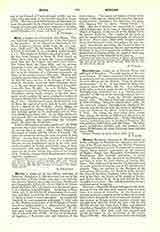

Mysore, (Maisour), Diocese of (Mysuriensis), in India, suffragan to Pondicherry, comprises the territory of the Mysore native state, the British Provinces of Coorg and Collegal, part of Wynaad and the taluk of Ossoor, Salem district; surrounded by the Dioceses of, Madras, Poona, Goa, Mangalore, Coimbatore, and Pondicherry. The Catholic population is about 48,202. The diocese, like the rest of the Pondicherry province, is under the Paris Society of Foreign Missions. The clergy are 65 in number (53 European and 12 native priests), having the care of 123 churches and chapels. They are assisted by the Brothers of the Immaculate Conception, the Brothers of St. Gabriel, the Nuns of the Good Shepherd Order, the Little Sisters of the Poor, the Sisters of St. Joseph of Tarbes, and Native Sisters of St. Anne and also of the Immaculate Conception. The cathedral and the bishop’s residence are at Bangalore.
History. Originally Mysore belonged to the Archdiocese of Goa, but what early mission work was done there is a matter of obscurity. In the Canarese or western portions a mission seems to have been established about the middle of the seventeenth century; in the eastern or Telugu portion another mission was brought into existence about the year 1703 by two French Jesuits who came from Vellore and founded churches at Bangalore, Devanhalli, Chikka, Ballapoora, and elsewhere. But their work was stopped and partly destroyed by the fanaticism of the sultan, Tipu (1782-99). The district came under the Foreign Mission Society of Paris in 1776, which at that date began work at Pondicherry. The celebrated Abbe Dubois (b. 1765, d. 1848), himself a member of the Foreign Missions, spent most of his life among the Canarese Christians of Ganjam, Palhally, and Satthully (see Dubois). Mysore was included in the Vicariate of the Coromandel Coast (Pondicherry), erected in 1836, but was separated in 1845, and erected into a distinct vicariate-Apostolic in 1850, at the same time as the district of Coimbatore. On the establishment of the hierarchy in 1886 it was made into a diocese suffragan to Pondicherry with the same boundaries as now.
Succession of Prelates., Vicars-Apostolic: Stephen Louis Charbonaux, 1850-73; Joseph Augustine Chevalier, 1874-1880; Jean-Yves-Marie Coadou, 1880-90 (became first bishop in 1886); second bishop, Eugene-Louis Kleiner, 1890 (absent in Europe since 1903); Augustine Francis Basle, coadjutor with right of succession, 1906, now ruling the diocese.
Institutions. St. Joseph‘s College, Bangalore, teaching up to F. A. Standard, with 600 pupils; Ban-galore Convent School under the Nuns of the Good Shepherd, with 494 pupils; St. Patrick’s School, Shoolay, with 156 pupils; St. Francis Xavier’s School for girls, Cleveland Town, with 138 day scholars; St. Aloysius’s School, with 210 boys; native ecclesiastical seminary, with 26 students; St. Louis’ Boarding School, with 58 boarders; the Brothers of the Immaculate Conception, training school for teachers, with 10 European students; convent school at Mysore, under the Good Shepherd Nuns, with 185 pupils; St. Joseph‘s School, Mysore, with 142 pupils; native Sisters of St. Anne, in charge of five native girls’ schools; native Nuns of the Immaculate Conception, girls’ school at Settihally, also a dispensary; Majanma Thumbu Chetty School for caste girls, under the Sisters of St. Joseph of Tarbes, Bangalore, with 136 pupils. Charitable Institutions. St. Patrick’s Orphanage, Bangalore, with 100 inmates; St. Martha’s public Hospital and Dispensary, Bangalore, in charge of the Good Shepherd Nuns, 70 beds; eye infirmary under the same; Little Sisters of the Poor, Bangalore, with 101 inmates; two orphanages at Bangalore and Mysore under the Good Shepherd Nuns with total of 263 inmates; also 2 Magdalene Asylums with 129 inmates. Four agricultural farms for orphans, round which Christian villages have been formed at four places in the diocese; several small orphanages in country parishes.
ERNEST R. HULL

